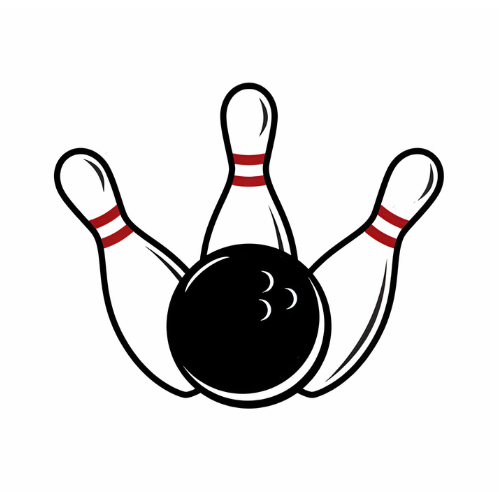At first glance, bowling seems all about hand and body movement in order to throw the ball to hit all the pins. However, To that, there is more. Professional bowlers spend a lot of time learning about various bowling lanes and balls. A bowler cannot predict the motion of the ball or take advantage of it if he does not comprehend the oil condition and how the ball responds to it. He will not achieve precision and, as a result, will fail to score. That being said, we are here to share our knowledge on two types of bowling balls that are essential for any bowlers, especially for medium to heavy oil lanes.

Reactive Resin Bowling Balls
The development of bowling ball cover stock is a never-ending process. Manufacturers always try to improve existing cover stocks and develop new ones. After the invention of urethane cover stock, bowling ball manufacturers didn’t rest. They wanted to create a bowling ball with better oil absorption quality than urethane. With that, reactive resin bowling balls were invented. Reactive resin bowling balls offer more friction and oil sensitivity compared to urethane. Now, reactive resin bowling balls can be of two types, solid reactive, and pearl reactive.
Variation between Solid and Pearl Bowling Ball
There are some variations between solid and pearl reactive bowling balls even though they are both made of reactive resin. Here, we’ll go into great detail about the variations between these two varieties of bowling balls. When compared to pearl coverstocks, solid reactive coverstocks typically offer a higher coefficient of friction. Solid reactive balls experience less energy loss as they move down the lane compared to pearl reactive coverstock balls because of higher surface friction, which also causes them to hook more quickly than pearl reactive balls.
Material
Both the solid and pearl bowling balls are composed of reactive resin. However, there are only some minor differences between these two. In terms of appearance, pearl reactive bowling balls are softer than solid bowling balls, which are more textured. Urethane bowling balls with additional additives were used to create reactive resin bowling balls. In comparison to urethane bowling balls, these compounds make reactive resin balls stickier. In comparison to pearl reactive bowling balls, solid reactive bowling balls have fewer additives in their cover stock. These components could be made of glass, rubber, ceramic, etc.
Oil Absorbing Quality
The additives in the solid and pearl create pores on the surface. Pearl bowling balls have more pores compared to solid bowling balls. The difference in pores or oil absorption makes a difference between solid and pearl reactive balls. These pores help in absorbing oils, making them tacky. This quality impacts the performance of the bowling ball. In general terms, a bowling ball will absorb oil as it goes down the lane. A ball will absorb dirt in addition to the oil. A clean cover must make contact with the lane floor in order for the bowling ball to hook strongly.
Friction
The coefficient of friction for solid bowling balls is greater than pearl reactive bowling balls. Having more surface friction, solid balls tend to differ in energy and hook. However, there are three types of finishes available for solid bowling balls. They are polished, sanded, and buffed finish. These finishes determine the level of friction for solid balls.
Energy Through the Lane
As we mentioned earlier, solid bowling balls have more coefficient of friction. This results in losing more power while rolling compared to pearl balls. Solid reactive bowling balls begin to lose energy as they move down the lane and hook sooner than they would have otherwise. Pearl reactive bowling balls, on the other hand, maintain power until the very end thanks to their reduced coefficient of friction. As a result, they have more force to firmly hook or hit pins. In short, pearl bowling balls skid through the lane while solid bowling balls lose power as they go.
Reaction to the Break Point
A major difference between a solid vs. a pearl bowling ball is the reaction at the breaking point. Pearl reactive balls skid through two-thirds of the lane and make a sharp turn. Pearl bowling balls are known for their incredible hooking potential. Additionally, as pearl balls do not lose much power during skidding, they hit the pins with immense power. On the other hand, solid bowling balls have less hooking potential compared to pearl bowling balls. They keep losing power through their track and end up with less power to hook. Therefore, the curve or hook of solid bowling balls is not as sharp as pearl bowling balls.
Accessibility
Both solid cover stock and pearl cover stock are suitable for intermediate to advanced bowlers. However, solid reactive bowling balls are comparatively easier to control among these two. As solid balls have less hooking potential, have more friction, and are more abrasive, they are ideal for those who are learning to hook. On the other hand, pearl reactive balls can be a little tricky to control and predict. Therefore, they are used by more advanced bowlers. Professionals or tournament bowlers should have both solid and pearl reactive as they both are equally needed. Solid reactive are suitable for heavy oil lanes, whereas pearl balls are for medium-dry lanes. So, when the lanes are fresh with oils, professionals use solid balls, and when the lane gets dry, they use pearl reactive bowling balls.
Durability
Dues to the build quality and material of the cover stock, solid reactive are more durable than pearl reactive bowling balls.
To Conclude
The differences between a solid reactive and a pearl reactive will be more evident when you throw them during the bowling game. You will notice the difference between performance, hook, and speed. Based on that, you can understand more about these two types of balls and how you can manipulate or control them to score.
